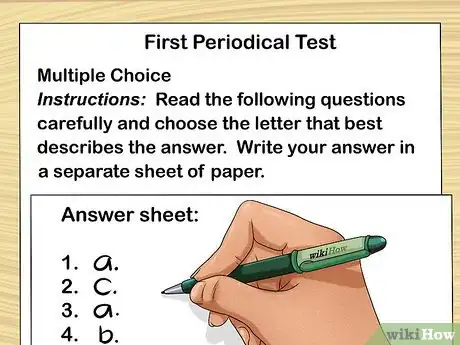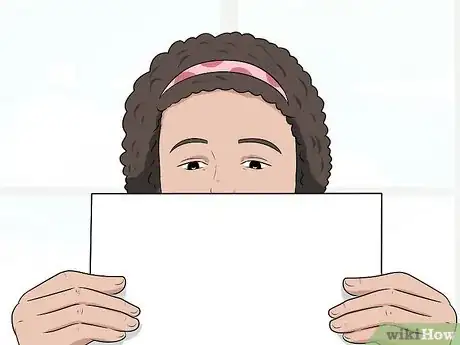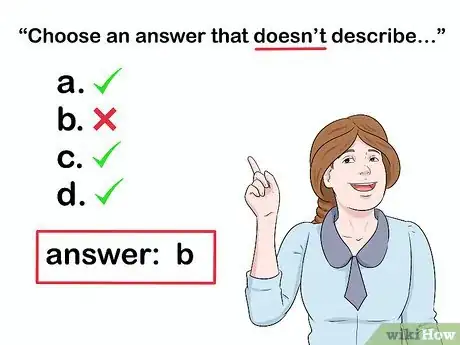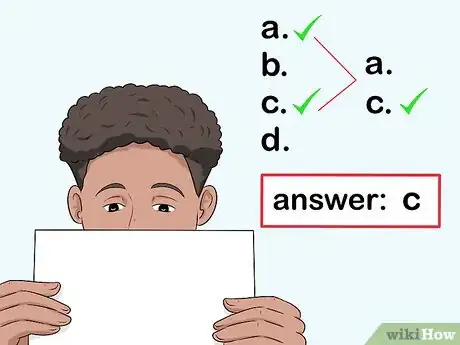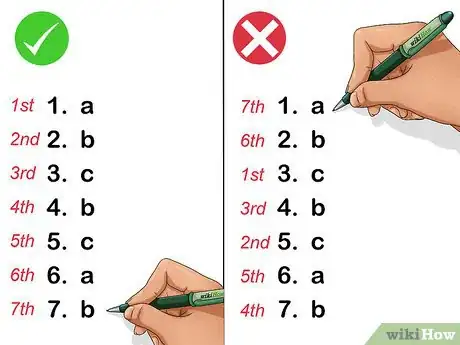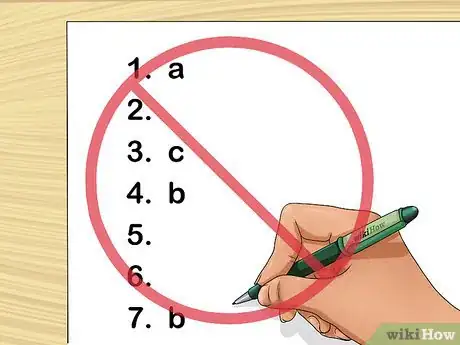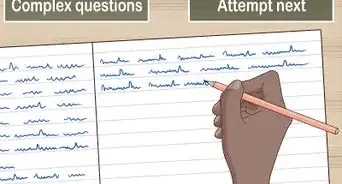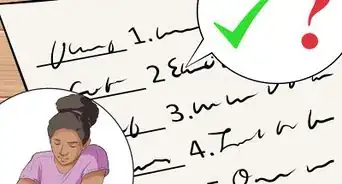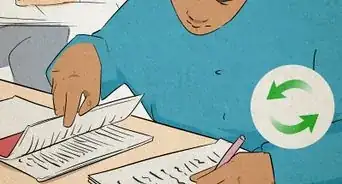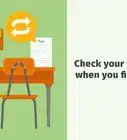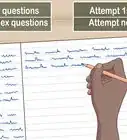This article was co-authored by Ted Dorsey, MA. Ted Dorsey is a Test Prep Tutor, author, and founder of Tutor Ted, an SAT and ACT tutoring service based in Southern California. Ted earned a perfect score on the SAT (1600) and PSAT (240) in high school. Since then, he has earned perfect scores on the ACT (36), SAT Subject Test in Literature (800), and SAT Subject Test in Math Level 2 (800). He has a BA in English from Princeton University and a MA in Education from the University of California, Los Angeles.
There are 9 references cited in this article, which can be found at the bottom of the page.
This article has been viewed 289,232 times.
Multiple choice exams are popular among educators, as they test a student’s critical thinking and problem solving skills. You may struggle with multiple choice exams and not know how to do well on them. To get a good grade on a multiple choice exam, start by analyzing the questions. Then, answer the questions effectively by working through them strategically. You can also prepare for the exam so you do well and get a high mark.
Steps
Analyzing the Questions
-
1Follow the instructions for the exam. Some multiple choice exams will ask you to write directly in the exam booklet. Others will have you write your answers in a separate answer key. Follow the instructions listed on the exam, or as given to you by your instructor.[1]
-
2Read the question carefully. Start by reading the exam question slowly and carefully.[2] If you are taking a physical test, use a blank sheet of paper to cover the possible answers below the question. This will allow you to focus on just the question.
- You can also read the question more than once to ensure you understand it. Take your time and do not rush through the question.
Advertisement -
3Analyze the wording of the question. Look for any negative phrases in the question, such as “Choose an answer that doesn’t describe…”. Check if there is a judgement phrase in the question like “Choose the most correct answer” or “Choose the best option.”[3]
- You should also analyze the question for any phrasing that asks for multiple answers to the question, such as “Choose more than one answer” or “Choose two of the four options.”
-
4Come up with your own answer to the question. Before you dive into the possible answers provided for the question, see if you can answer it on your own. Think about the question and come up with your own answer based on your existing knowledge.[4]
- Doing this can help you think of an answer before you look at the multiple choice options. Chances are, the answer you come up with is one of the options for the question.
- If you can’t come up with your own answer, don’t fret. You can use the answers provided to come up with the right answer for the question.
-
5Look for qualifiers. Qualifiers are words that express specific circumstances or conditions. These will help you limit the number of possible answers.[5] There are a few categories of qualifiers:
- Indications of time: before, after, while, always, never
- Superlatives: most, least, most common, fastest, the best, the only
- Conditionals: each time X happens, if X happens, unless X, assuming X
Answering the Questions Effectively
-
1Review all the possible answers. Once you have processed the question, look at all the choices presented to you. Most multiple choice exams provide four to six possible answers per question. In some cases, you may only be given two options.[6]
- Take your time and read over each possible answer. Do not skim or skip over any possible answers. This will ensure you make an informed decision about the correct answer to the question.
-
2Eliminate the answers that appear incorrect. Put a small mark by answers that appear incorrect right away. You may know that one or two answers are incorrect, or have a strong feeling they are not right. Eliminate any answers that seem incorrect to you, based on your interpretation of the question.[7]
- Look for possible answers that have “always,” “never,” and “none of the above” in them, as they are usually incorrect.
- When you go over the answers, avoid thinking that your instructor is trying to trip you up with sneaky or confusing options. Most instructors won't give you "trick" answers like this.
-
3Look for an answer that fully addresses the question. Ask yourself whether the answer you have chosen fully answers the question. Do not go for an answer that only partly answers the question, as it is likely incorrect. Trust your gut feeling and go for an answer that responds fully to the question and seems correct to you.[8]
- For example, you may be torn between two answers for the question. Try out both answers for the question. Read the question to yourself and place each answer at the end of the question. Pick the one that appears the most correct to you.
-
4Answer the questions in order. Do not skip around on the test and answer the ones you know first. Skipping around can waste valuable time, especially if you are doing a timed exam. Try to work through each question one at a time and in order so you make sure you answer them all to the best of your ability.[9]
- If you get stuck on one question, try to work through it slowly. If you are really stumped, put a star or mark next to it so you know to come back to it at the very end of the exam.
-
5Do not leave any questions unanswered. Doing this can make you lose points on the exam. In some cases, leaving the questions blank will gain you no points or the instructor may deduct points. Choosing an answer based on your judgement and knowledge may land you at least one or two points more on the exam.[10]
- When in doubt on an answer to a difficult question on the exam, go with your best judgement and choose the best answer you can identify from the list of options.
Preparing For a Multiple Choice Exam
-
1Study in advance for the exam. To do well on a multiple choice exam, you should make a point of studying ahead of your exam date. Make a study schedule for the exam and set aside the necessary time for studying.[11] Study in the week leading up to the exam or several days beforehand.[12]
- Cramming for the exam will cause you a lot of stress and anxiety. You may not retain information well if you cram the night before the exam, leading to a poor grade.
-
2Ask the instructor for examples of past exams. If you have struggled with multiple choice exams in the past, you may ask the instructor if they can provide practice tests for the course. You can also ask them for examples of questions from old exams.[13]
- Use the old exams and example questions to prepare for the test. Study the structure of the questions as well as the provided answers. Take several practice tests to get better at multiple choice style exams.
- If the instructor will not give you past exams, join a study group so you can study with others. You can also get a study tutor to help you study for the exam.
-
3Get enough sleep and eat healthy. Make sure you get at least eight hours of sleep the night before the exam.[14] This will ensure you are sharp and ready on test day. You should also have a good meal the night before the exam, and in the morning before the exam.
- Make sure you have a good breakfast high in protein, vitamins, and nutrients, like eggs, toast, and fruit, or yogurt and granola.
-
4Do a calming activity before the exam. Don't do last-minute revisions as this is just more likely to stress you out. Instead, chat with a friend about something other than the test, or listen to calming music.
-
5Study with trusted friends, and keep out of distractions, such as parties. This can cause to fail, distract you from the test you are studying.[15]
Community Q&A
-
QuestionHow do I answer multiple choice questions?
 Community AnswerCancel out the options that either are completely absurd or you know are false. Quickly scan the remainder, and think of the key words connecting them to your notes. Use diagrams and information given to help, and read the question again.
Community AnswerCancel out the options that either are completely absurd or you know are false. Quickly scan the remainder, and think of the key words connecting them to your notes. Use diagrams and information given to help, and read the question again. -
QuestionHow do you know when the answer you gave is wrong, when in doubt?
 Community AnswerYou don't. The article point means that you should simply try harder to think ,and cross out any wrong answers in the question, so as to narrow it down.
Community AnswerYou don't. The article point means that you should simply try harder to think ,and cross out any wrong answers in the question, so as to narrow it down. -
QuestionHow do I guess?
 Community AnswerFirstly, eliminate the option that you're sure is least likely. Then evaluate the other options and see if you can narrow it down further.
Community AnswerFirstly, eliminate the option that you're sure is least likely. Then evaluate the other options and see if you can narrow it down further.
References
- ↑ https://www.butte.edu/departments/cas/tipsheets/studystrategies/multiple_choice.html
- ↑ https://www.educationcorner.com/multiple-choice-tests.html
- ↑ https://student.unsw.edu.au/multiple-choice-exams
- ↑ https://student.unsw.edu.au/multiple-choice-exams
- ↑ https://umanitoba.ca/student/academiclearning/media/Tips_on_Taking_Multiple_Choice_Exams_NEW.pdf
- ↑ https://student.unsw.edu.au/multiple-choice-exams
- ↑ https://www.educationcorner.com/multiple-choice-tests.html
- ↑ https://www.dmu.edu/wp-content/uploads/MULTIPLE-CHOICE-TEST-TAKING-STRATEGIES.pdf
- ↑ https://www.socialpsychology.org/testtips.htm
- ↑ https://www.butte.edu/departments/cas/tipsheets/studystrategies/multiple_choice.html
- ↑ Ted Dorsey, MA. Academic Tutor. Expert Interview. 11 December 2019.
- ↑ https://learningcenter.unc.edu/tips-and-tools/studying-101-study-smarter-not-harder/
- ↑ https://student.unsw.edu.au/multiple-choice-exams
- ↑ Ted Coopersmith, MBA. Academic Tutor. Expert Interview. 10 July 2020.
- ↑ https://learningcenter.unc.edu/tips-and-tools/studying-101-study-smarter-not-harder/
